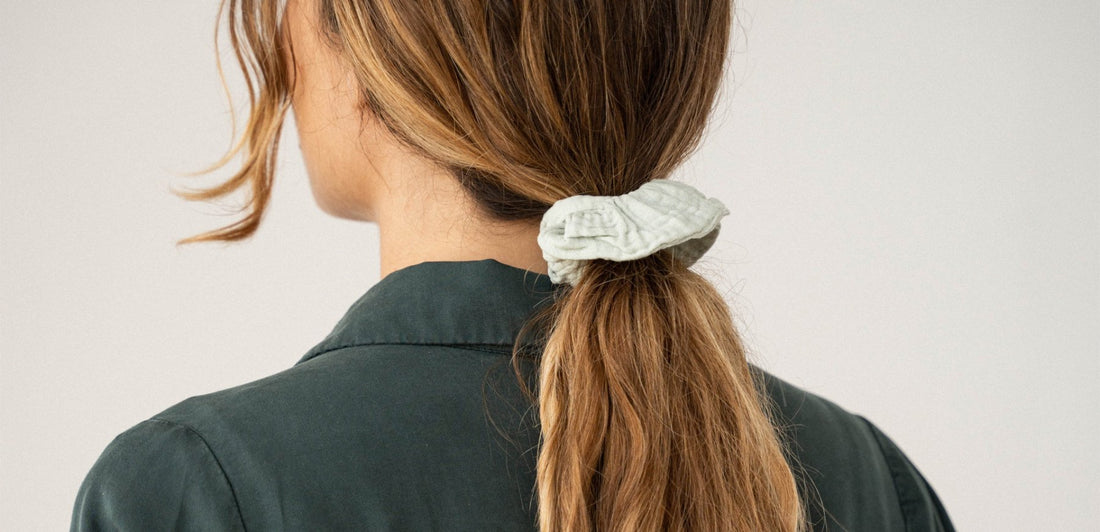What is muslin?
Muslin is a loosely woven cotton fabric that has a lightweight, smooth, and absorbent quality as well as a distinctive rippled look. It is typically made of thin layers that are sewn together to form the desired thickness. Muslin has a vibrant cultural history spanning millennia - we’ll get into that later - and plays a versatile role in modern fashion. It is soft enough to swaddle babies in and strong enough to make beautiful dresses - or scrunchies! We think muslin looks especially good in pastel colours, as the texture can truly shine. One of our star materials this summer: it's about time we got to grips with this fascinating and highly wearable fabric that was once compared to “woven air.”
1. It’s one of the world’s oldest fabrics.
Muslin dates back more than 2,000 years to Ancient India. Dhaka, now the capital of Bangladesh, is still considered the home of the very finest Muslin fabrics, which once boasted extremely high thread counts (as high as 1,000!).
2. Muslin was worn by Greek goddesses.
Those goddesses may have been made of stone, but there’s no doubt the Ancient Greeks regarded muslin as a venerable fabric! They imported muslin from India to clothe their statues of deities.
3. Even the name has layers to it!
Muslin’s name is most often thought to be derived from the English traders who discovered it in Mosul, Iraq. But it may also derive from the French word for foam (“mousse”). To the French, mousseline actually meant “cloth of silk and gold”, a reflection of its immense value to traders of the renaissance era.
4. An 18th Century scandal.
Muslin caused a minor scandal when it was introduced into European society in the 18th Century. It was the subject of sexsist cartoons that depicted the women of the era in a state of undress. That didn’t stop Marie Antoinette becoming a muslin fashion icon!
5. 100% natural.
Muslin is usually made from natural fibres that create less emissions than synthetics and are more biodegradable. Our muslin is made from 100% organic cotton, which makes it even better for skin and soil, as no pesticides are used.
6. Muslin is ultra soft.
One of the strongest qualities of muslin is that it’s soft! So soft in fact, that it is often recommended for sensitive skin. Muslin also soaks up and holds moisture well, and is the perfect fabric for summery weather as it is usually more lightweight than regular cotton.
7. The dressmaker’s first draft.
Despite its luxury connotations, muslin production increased dramatically after the industrial revolution, turning it into an affordable and adaptable fabric. Many would (rightly) argue that this led to a decrease in quality, but dressmakers certainly didn’t complain. They used muslin to test and sample dress styles. To this day, dress prototypes continue to be referred to as “muslin” regardless of the fabric they are made from.
It should be stressed that the muslin used in the majority of western clothing is distinct from the ultra-fine, Dhaka muslin that is currently under revival after going virtually extinct. While it shares some characteristics (and a name!), the originators of this beautiful fabric crafted their muslin to unmatchable standards. It’s also fair to say that this type of muslin is much much more transparent.
Is muslin sustainable?
Our muslin is indeed sustainable. It’s constructed from 100% organic cotton, which has a lower impact on the planet than conventional cotton, deriving from farming techniques that use less water and avoid pesticides.
To produce scrunchies, we make use of existing stock muslin, thereby avoiding fabric waste.
How to care for muslin fabric?
Muslin is a delicate fabric and should be handled accordingly. Here’s a selection of top tips to follow as you care for a muslin garment.
- Machine wash or hand wash muslin using cold water only.
- Use gentle laundry detergent. A natural or eco-friendly one will do the trick.
- Hang the item up or lay muslin flat to dry. If tumble-drying, use a low heat and remove the garment before it is completely dry.
- But… check the label first. Care information will vary by garment / accessory.









